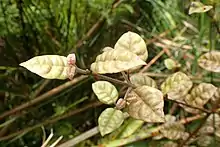Lophomyrtus bullata
Lophomyrtus bullata, also known by its Māori name of ramarama, is a species of evergreen myrtle shrub in the genus Lophomyrtus, family Myrtaceae. It is endemic to New Zealand.[1]
| Lophomyrtus bullata | |
|---|---|
_(8600619544).jpg.webp) | |
| 1854 illustration by Walter Hood Fitch | |
| Scientific classification | |
| Kingdom: | Plantae |
| Clade: | Tracheophytes |
| Clade: | Angiosperms |
| Clade: | Eudicots |
| Clade: | Rosids |
| Order: | Myrtales |
| Family: | Myrtaceae |
| Genus: | Lophomyrtus |
| Species: | L. bullata |
| Binomial name | |
| Lophomyrtus bullata | |
| Synonyms[1] | |
| |

Ramarama growing in Auckland Botanic Gardens
Lophomyrtus bullata grows to a height of 8 metres, producing many branches closely packed together. The leaves are oval shaped, thick, shiny and bubbled, varying in colour from dark green to yellow green. They can also appear spotted with red, maroon, or blackish marks.
Ramarama flowers between November and March, and subsequently fruits from January through to June.[2]
As of 2020, ramarama has become severely threatened by myrtle rust (Austropuccinia psidii), a pathogenic fungus that arrived in New Zealand in 2017.[3]
References
Wikimedia Commons has media related to Lophomyrtus bullata.
- "Lophomyrtus bullata". New Zealand Plant Conservation Network. Retrieved 2022-05-11.
- "Ramarama (Lophomyrtus bullata)". Taranaki Educational Resource: Research, Analysis and Information Network. Retrieved 3 April 2012.
- Neilson, Michael (3 December 2020). "Myrtle rust ravaging East Cape, with ramarama dying and pōhutukawa infected for the first time". The New Zealand Herald. Retrieved 4 December 2020.
This article is issued from Wikipedia. The text is licensed under Creative Commons - Attribution - Sharealike. Additional terms may apply for the media files.